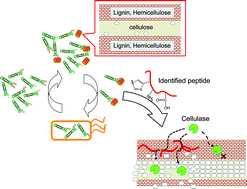Biomass-binding peptides designed by molecular evolution for efficient degradation of cellulose in biomass by cellulase†
Abstract
Molecular evolution was used to generate capping molecules that selectively bound to the noncellulose components in cellulosic biomass and facilitated access of cellulolytic enzymes to the substrate components. The


 Please wait while we load your content...
Please wait while we load your content...